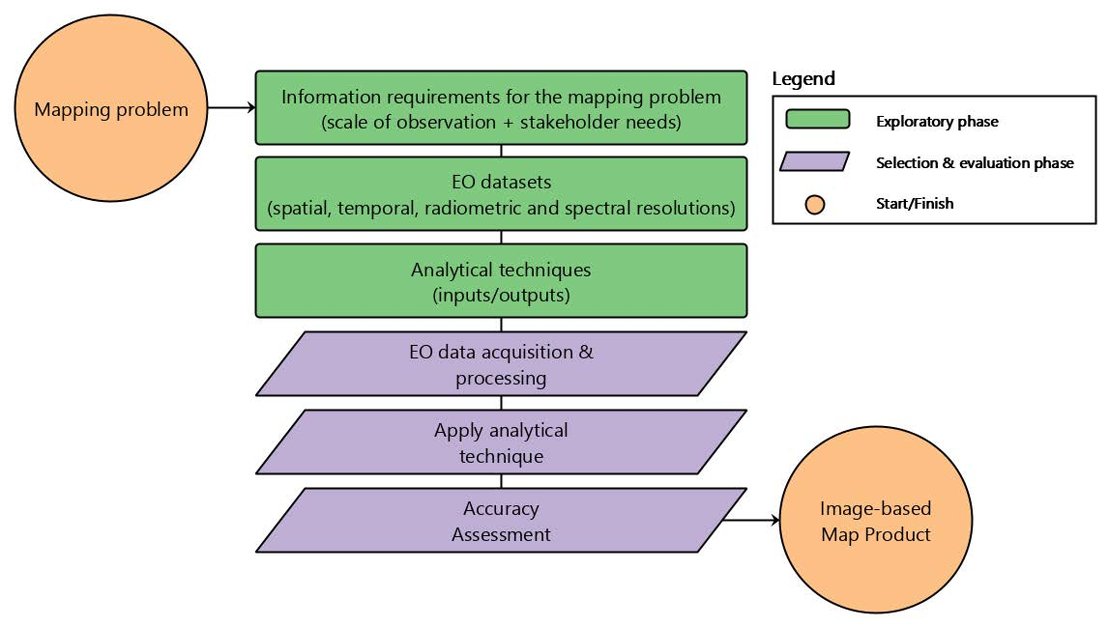Earth Observation for natural resources Management (7,5 ECTS)
-with special emphasis on spatial ecology, agriculture and forestry
The 21st century has witnessed an increase in the availability of Earth observation (EO) data and their use in addressing critical problems in natural resources management (NRM). The myriad of datasets and stakeholder needs can make the selection of a specific sensor and analytical technique to address a problem a daunting task. At the heart of this dilemma is the scale of observation at which we can effectively address the problem. Biophysical processes, flows or interactions can occur at the plant, canopy or regional scale. These scales of observation correspond to spatial resolutions of 0.01-1m, 1-100m and 1-1000km over daily, monthly and annual time steps, respectively. Similarly, image-based map products have a specific purpose. For example, food security analysts may want to know the location of crop field boundaries in an agroecosystem, while foresters may want to assess forest stand biomass. We can address these problems effectively with very high spatial resolution (VHR) optical imagery. Object-based image analysis (OBIA) and vegetation indices, which are common analytical techniques applied to VHR optical imagery, can delineate discrete crop field boundaries and estimate vegetation index-based tree fractions correlated to forest stand biomass.
The guiding principle of this course, therefore, is to use the scale observation together with stakeholder needs to select and apply an appropriate EO dataset and analytical technique to solve problems within the three NRS Forest, Agriculture and Environment in the Spatial Sciences (FORAGES) themes (biodiversity conservation, forest management and food security analysis). In the end, students will be able to design a workflow to address these problems that includes the appropriate selection of EO data and analytical techniques.
The course begins with an introduction to the Phinn et al. (2003) framework for choosing an “optimal” EO dataset and analytical technique for ecosystem analyses (Figure 1). Students will use this framework throughout the entire course to address problems within the FORAGES themes.

Figure 1: U19-NRM-101Course Framework (adapted from Phinn et al., 2003)
The main body of the course consists of teaching units that address two problems related to forestry, Agriculture and environment (Figure 2). In most cases, teaching units will include a lecture, short practical/tutorial and full practical spanning a two-day period. The lecture is exploratory in nature. It introduces the FORAGES topic and provides an overview, i.e. mapping problem + scale of observation + stakeholder needs + pros and cons of different types of EO data and analytical techniques. A short practical or tutorial following the lecture demonstrates one EO dataset used in the literature to address the problem. Following the lecture and tutorial, students during self-study, review relevant online sources, journal articles and book chapters to enrich their understanding of the problem and selected EO dataset. On the second day, students use an analytical technique to create an image-based map product from the selected EO dataset.

Figure 2: Conceptual diagram of MAP
The remainder of the course concerns content integration and cross-fertilization. Students generate a land cover map for a specific problem in the Lemele study area. They use the Phinn et al. (2003) framework to design and execute a workflow to generate the map. The case study includes a 2-day teaching unit on sampling theory and design + accuracy assessment and a virtual fieldwork, simulating the collection of ground truth data to calibrate/validate their selected analytical technique.
Further reading
Phinn, S.R., Stow, D.A., Franklin, J., Mertes, L.A.K., Michaelsen, J. 2003. Remotely Sensed Data for Ecosystem Analyses: mCombining Hierarchy Theory and Scene Models. Environmental Management, 31(3): 429-441.
We are always curious to receive feedback and comments on the content, material and organization of our education. So, please, help us further improve our work by sharing your opinion about this course.
We hope that we will be able to fulfill your expectations and wish you good luck and pleasure in participating in this course.
